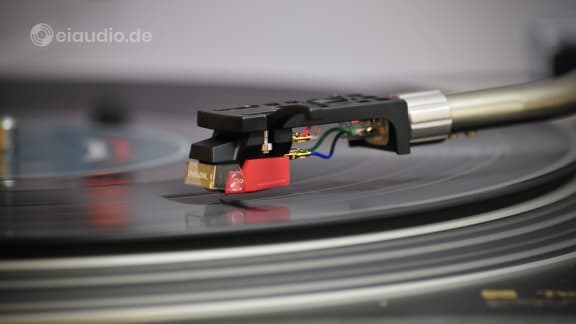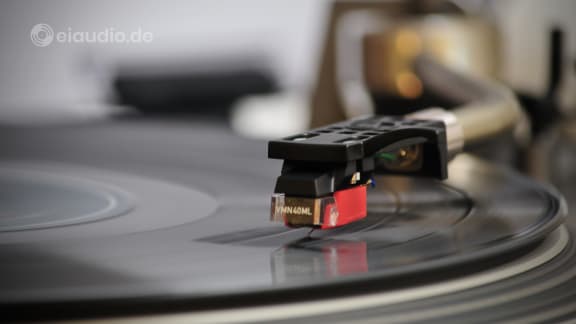AT VM540 ML
Published: 28/10/2021
Manufacturing date: 2020
Author: Karsten Hein
Category: Gear & Review
Tag(s): Phono Cartridges
As some of you might remember from my review of our Technics SL1310 turntable, this had moved in with us equipped with its original Shure M75 cartridge and ED stylus (elliptical diamond) from the late 1970s. In order to assure that the worn cartridge would not destroy our records, I had first checked the stylus under a microscope and found it fit to perform. There were some initial electric issues on the left channel, which our trusted technician solved by pushing a faulty pin into the cartridge with his soldering iron. He had thereby re-established the connection, and the turntable did perform well, until recently, when the left channel failed once again. It was high time to make a change.
Upon inspecting the tonearm of the Technics, I was reminded that this table already featured the practical half-inch headshell mount. Therefore, if I was going to invest in a new cartridge, I could also easily exchange the headshell and wiring along with it. And, since the headshell held both the cartridge and connectors, its resonances and the quality of its wiring would have some influence on sound quality. I checked the web for possible cartridge and stylus combinations and shortlisted three rather affordable MM (moving magnet) models among the more audiophile specimen that were all designed for medium-compliance tonearms: the Ortofon 2M Silver, the Nagaoka MP-150 - which is actually an MI (moving iron) cartridge and thereby similar to an MM - and the Audio Technica VM 540 ML.
Advert eiaudio/shop:
Among the tree cartridges, the Audio Technica had the most sophisticated stylus, and, since we were still very happy with our previous purchase of the Audio Technica VM 95 ML for our Sansui SR-525, I was curious to explore the differences between the two cartridges of the same manufacturer, that were both equipped with micro-linear styli, with the specifications of the 500 series being slightly superior to those of the 95. To confirm the result of my musings, I discussed my considerations with a gentleman at thakker.eu, who confirmed that the sophistication of its stylus placed the ML version ahead of the competition at the given price point. For the 500 series, the total choices of styli were as follows:
Stylus Choices
- AT-VM510 CB = Conical - Bonded Round Shank
- AT-VM520 EB = Elliptical - Bonded Round Shank
- AT-VM530 EN = Elliptical - Nude Round Shank
- AT-VM540 ML = Microlinear - Nude Square Shank
- AT-VM550 SH = Shibata - Nude Square Shank
- AT-VM560 SLC = 0.28 x 1.5 Mil Special Line Contact
Except for the VM560 SLC, which was more than double the price of the VM540 ML (and at that time Audio Technica’s most expensive MM cartridge ever), the micro-linear version was considered to be the most versatile performer among the choices. Although the 500 series would still be deemed an entry-level cartridge by some, the stylus's micro-linear cut in combination with the nude mounting on a square shank made the ML very capable of extracting the tiniest nuances from the record groove. Similar to the 95, the 500 series cartridge used dual magnets that were arranged in the shape of a ‘V’ to resemble the shape of the cutter-head. The design was to assure maximum amplitude and improved channel separation. The cartridge had been laid out to work equally well on most low and medium mass tonearms. In its VM540 ML/H version, it came pre-mounted on Audio Technica’s HS-10 headshell, and I decided that this was the most practical solution for our SL1310.
When the cartridge arrived, I was pleasantly surprised by the easy way in which I could twist the headshell out of its socket in the packaging and decided that I would use this same box to securely store our old headshell. As I had already been warned by the vendor, the cartridge first needed to be aligned to fit the specific layout of the SL1310. I used my old alignment protractor, on which the inner groove position can be aligned with the device staying in place, and was pleasantly surprised that the VM540 ML’s fold-down stylus cover also served in setting the correct angle and overhang. It produced a straight line on the protractor which made it easier to perform the setting. I also noticed that the new VM540 ML/H was lighter than our original setup, which meant that I had to dial back the tonearm weight quite substantially. I set the overhang and adjusted the tracking force to the recommended 2.0 grams using our digital tracking force scale.
One thing that took me a little by surprise, was the fact that I had to disconnect the SL1310 from the wall socket in order to perform these settings, as I could not shift the tonearm sideways without activating the built-in autostart. The platter jumped into action each time the tonearm was brought near to it, and, although this was quite clearly a feature of the automatic drive, it took me a moment to appreciate that there was no way around physically pulling the plug. Perhaps this is just me, but for some reason pulling the plug seemed rather crude to me, and I could not shake the feeling that I had overlooked some detail, like an on/off-switch perhaps.
When I finally did sit down to listen, I could hardly believe the improvement I was hearing over the previously mounted Shure M75 ED. There was simply more of everything. Listening to Carmen Lundy’s album “Soul to Soul”, I first noticed the superior exactness of the micro-linear stylus. And even though I had already experienced this effect in transitioning to the ML cartridge on our Sansui SR-525 turntable, I was deeply impressed once again. I had become so familiar with the little inaccuracies of our vintage Shure cartridge that hearing the album without them brought a whole new sensation to the medium. The VM540 ML produced a very low noise floor, showed no sibilance at all, and was capable of providing a highly accurate impression of the original musical event. And while it presented lots of musical detail, it did so in great harmonic coherence with no aspect being accentuated. I found this to be enjoyable, engaging, and superbly balanced at the same time.
The Audio Technica made our Tannoy XT8F loudspeakers sound larger and more intense than I was previously used to. The soundstage was excellent, with Lundy’s voice positioned smack center stage and all instruments arranged spaciously around her. This effect was aided by the long-trailing decay of individual tones. Transients had always been a special strength of the ML styli. In Lundy’s “Sardegna”, the xylophone appeared to be almost three-dimensional with individual notes appearing as vividly as bubbles in a glass of champagne. Trumpets and higher piano notes reached deeply into the room, whereas percussions remained slightly recessed. Bass notes were present but not as pronounced as they had been on the Shure. This impression stayed the same, even after I changed to Ted Poor’s album “You Already Know” that has much stronger bass lines. Instead of being boomy or overly extended, bass remained nuanced and controlled at all times. Bass enthusiasts would probably do well to increase tracking force to 2.2 or 2.5 grams, but I usually prefer stellar transients over mighty bass roar.
The Helge Lien Trio’s “Guzu Guzu” was more densely arranged than the previous two albums and gave the VM540 ML cartridge opportunity to show that it could also stay accurate in more volatile and cluttered situations, in which a multitude of natural sounds from acoustic instruments overlap. To my great satisfaction it also played this album effortlessly and smoothely to the last groove, accurately tracing each nuance without loosing itself in the detail. When compared to the VM 95 ML of the same company, I found that the two are very similar, but that the VM540 ML plays vocals with a softer and more balanced top end. This could be due to its extended frequency range or superior channel separation, but it could just as well be attributed to the periphery used. Technics decs are said to be very well engineered turntables. At this point, I can only say for certain that the VM540 ML was much easier to align with the built-in stylus protector folded down. If you are thinking about upgrading a vintage turntable with low or medium mass tonearm, Audio Technica’s 500 series is certainly worth considering.
Specifications
- Sound: Silent on the record, balanced and highly nuanced, warm with silky vocals, controlled and well-contoured bass
- Type: dual moving magnet
- Frequency Response: 20-27.000 kHz
- Channel Separation at 1KHz: 28 dB
- Input Load: 47,000 Ohm
- Output at 1KHz 5cm/sec.: 4mV
- Recommended Tracking Force: 2.0 g
- Stylus Type: Nude Micro Linear Square Shank
- Inductance: 550 mH
- Resistance: 485 Ω
- Weight: 6.4 g
- Height: 17,3 mm
- Year: 2020 -
- OSP: EUR 246,00 (Germany)
- Stylus Replacement: VMN40ML
Sound impressions based on the following system: Technics SL1310 record player, Dynaco PAS4 preamplifier, Hafler XL 280 power amplifier, Tannoy XT8F loudspeakers.
-->





